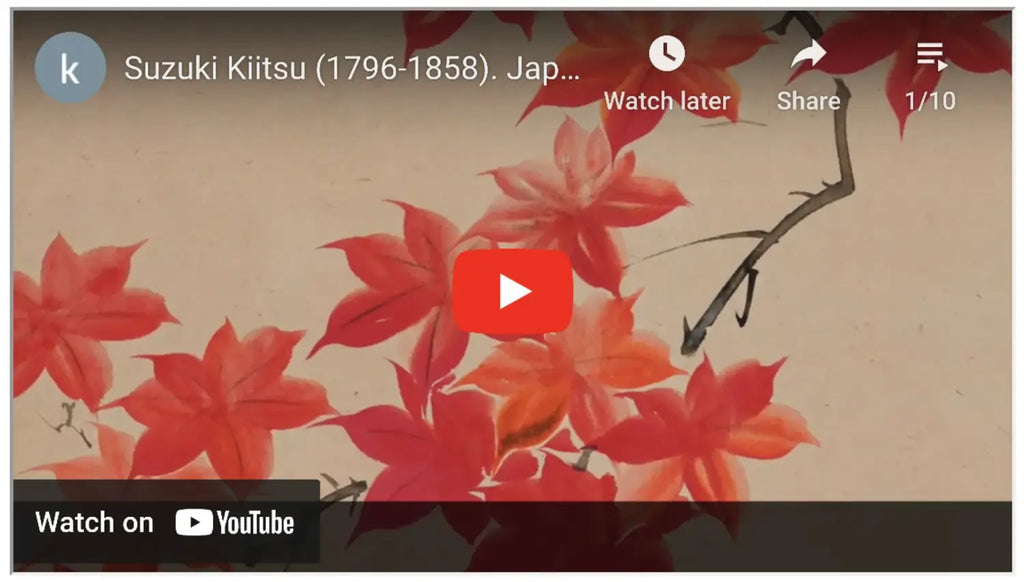On a quiet afternoon in Kyoto, you can still feel the hum of centuries overlapping-monks in saffron robes weaving between quiet shrines, artisans polishing brass door knockers, the distant laughter of visitors leaning over cups of matcha in elegant teahouses. This city, for so many generations the center of Japan’s imperial pageantry, gave birth to an art movement whose very name summons an entire cosmos of color and motion: Rinpa.
Our story begins in the early seventeenth century, on streets lined with paper lanterns and in salons perfumed by incense and boundless creativity. Within these hush-filled quarters, the Rinpa School-often spelled in Roman letters but pronounced in breathy Japanese syllables-emerged as an audacious new fusion of aesthetic refinement and artistic innovation. Far from remaining a museum piece of Japanese tradition, it sparked aftershocks that reverberated out into the worlds of painting, textiles, ceramics, and beyond.
Even now, gazing upon a Rinpa masterpiece can feel like stepping into another dimension, a place where your senses awaken to bold colors, lyrical patterns, and whispered evocations of classical Japanese literature. Its visual language, though centuries old, resonates with a vibrancy that continues to fascinate contemporary audiences.
Key Takeaways
- Kyoto's Luminous Legacy: Born amidst incense-infused salons of 17th-century Kyoto, Rinpa art unites vivid color, lyrical patterns, and breathtaking innovation-crafting a visual poetry that continues to resonate centuries later.
- Masters of Innovation: From Ogata Kōrin's radical abstraction and gold-flecked masterpieces to Sakai Hōitsu’s reverent reinvention, Rinpa thrived by gracefully blending tradition with daring creativity.
- Colors That Sing, Techniques That Whisper: Rinpa's dramatic hues and the mesmerizing technique of tarashikomi-the artful play of pigment and water-imbue each piece with a dreamlike depth, blurring the line between deliberate craft and poetic chance.
- Beyond Canvas and Brush: Rinpa effortlessly transcends mediums, finding radiant expression in textiles, ceramics, lacquerware, and even Western Art Nouveau, proving that true art cannot be contained within borders or disciplines.
- Timelessness Through Transformation: The secret to Rinpa's enduring allure lies in its boundless ability to evolve-bridging classical Japanese literature with modern aesthetics, connecting Kyoto's quiet temples with Parisian salons, and proving that true beauty is eternally contemporary.
The Revival’s Radiant Bloom: Ogata Kōrin and the Consolidation of Style
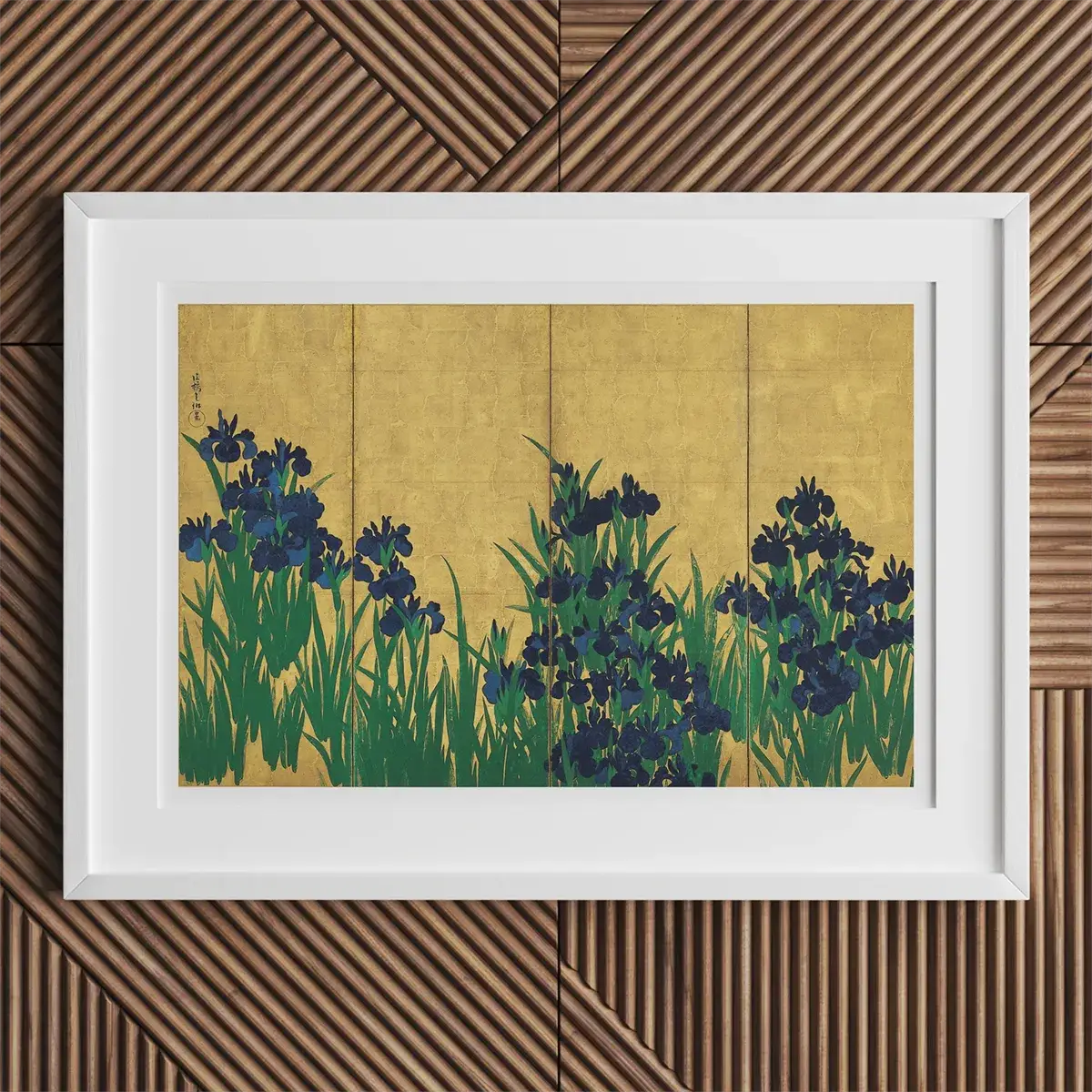
Rinpa was never a static style chained to a certain century; rather, it has flowed, meandered, and remade itself-like ink on a gold-flecked screen-across generations of artists unbound by rigid rules. What follows is a chronicle of that movement: its birth, its remarkable technique, its diaspora into new forms, and the men and women who shaped it into a brilliant tapestry that still dazzles the senses today.
Time carried the Rinpa sensibility forward like a favored aria echoing through Kyoto’s corridors. Then came a second moment of blazing illumination: the late seventeenth and early eighteenth centuries, presided over by Ogata Kōrin (1658-1716).
This era-known in Japanese history as the Genroku era (1688-1704)-was a moment of exuberant style and cultural renaissance. It was so transformative for Rinpa that the movement itself would later be named for Kōrin: “Rinpa” literally means “School of Kōrin.”
Kōrin’s brilliance lay in how he fused abstraction with nature. Whereas early yamato-e traditions favored meticulous lines and lyrical storytelling, Kōrin dared to collapse depth, contort perspective, and push color to new extremes. On occasions, he wove in gold or pearl to lend luminous surfaces that still dazzle modern viewers. In his studio, the depiction of an iris or a plum blossom could pivot from serene naturalism to near-abstraction in a single brushstroke.
Two paintings from Kōrin’s hand survive as the veritable holy grails of Rinpa’s visual ethos: “Irises at Yatsuhashi” and “Red and White Plum Blossoms.” What stuns viewers is that each composition, in its lavishly simplified forms, holds an undercurrent of raw emotion. The flowers seem to pulse with the breath of the seasons. These works heralded a shift from classical yamato-e influences toward something unmistakably new-a style unafraid to revel in the sheer joy of color and design.
Just as Kōetsu once collaborated with Sōtatsu, Kōrin found a natural creative foil in his own younger brother, Ogata Kenzan (1663-1743), renowned as a master potter. Glowing ceramics emblazoned with stylized waves or blossoms invoked the same aesthetic principles found on Kōrin’s screens. This spirit of shared exploration extended into pattern books, which Kōrin made widely available to artisans so that the Rinpa style could migrate into everything from ceramics to kimono textiles. In the consciousness of Edo-period Japan, “Rinpa” had become more than a brand of painting; it was an approach, a visual set of mantras that might bring vitality and elegance to any craft.
Echoes in Edo: Sakai Hōitsu and the 19th-Century Renaissance
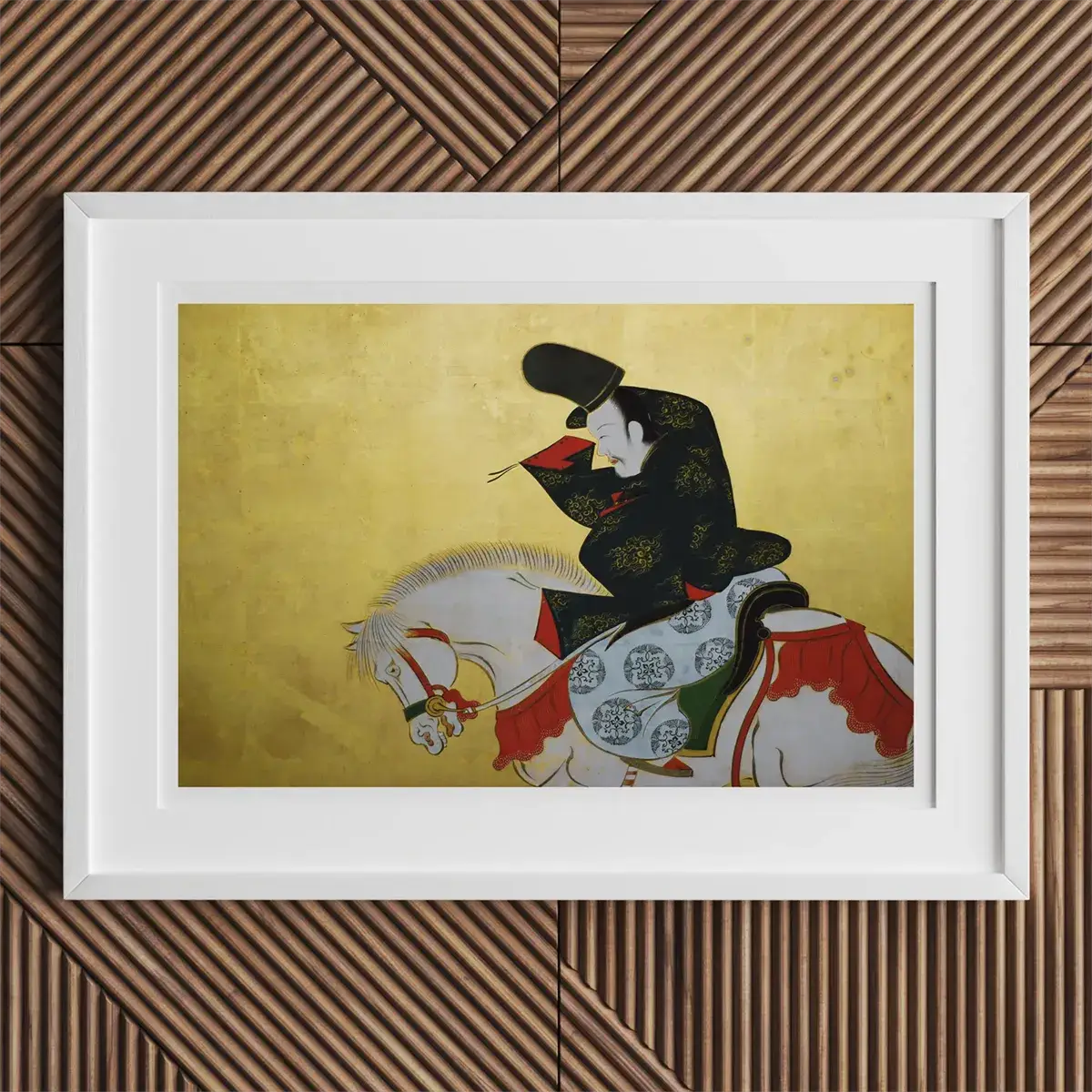
Cities evolve; capitals shift. By the nineteenth century, Kyoto’s once-unrivaled cultural influence had to reckon with the meteoric rise of Edo (present-day Tokyo). Yet, even as the geographic center of authority shifted, Rinpa found new life through the brush of Sakai Hōitsu (1761-1828).
Haunted by his admiration for Ogata Kōrin, Hōitsu scoured the remains of Kōrin’s works, copying them stroke by stroke to distill and preserve the essence of Rinpa. Some might see mere emulation, but for Hōitsu it was a testament, a way of forging an unbreakable link to the golden age of Kōrin’s Kyoto. As Edo blossomed into a bustling metropolis, Hōitsu introduced a subtle transformation: a heightened focus on natural imagery, especially the four seasons, veering slightly away from the literary motifs that had dominated earlier centuries.
In a most remarkable act of reverence, Hōitsu painted his “Flowering Plants of Summer and Autumn” on the reverse of Kōrin’s venerated “Wind God and Thunder God” screens, effectively bridging centuries of aesthetic legacy on a single pair of folding panels. This gesture was part homage, part collaboration across time.
From Hōitsu’s studio sprang another luminary: Suzuki Kiitsu (1796-1858), who took the Edo Rinpa style in a more naturalistic direction, particularly in the representation of flowers and other botanical life. Under Kiitsu’s hand, Rinpa’s decorative essence converged with delicate natural realism, injecting a further note of poetry into the tradition.
The Painter’s Palette: Decoding the Bold and Expressive Colors of Rinpa
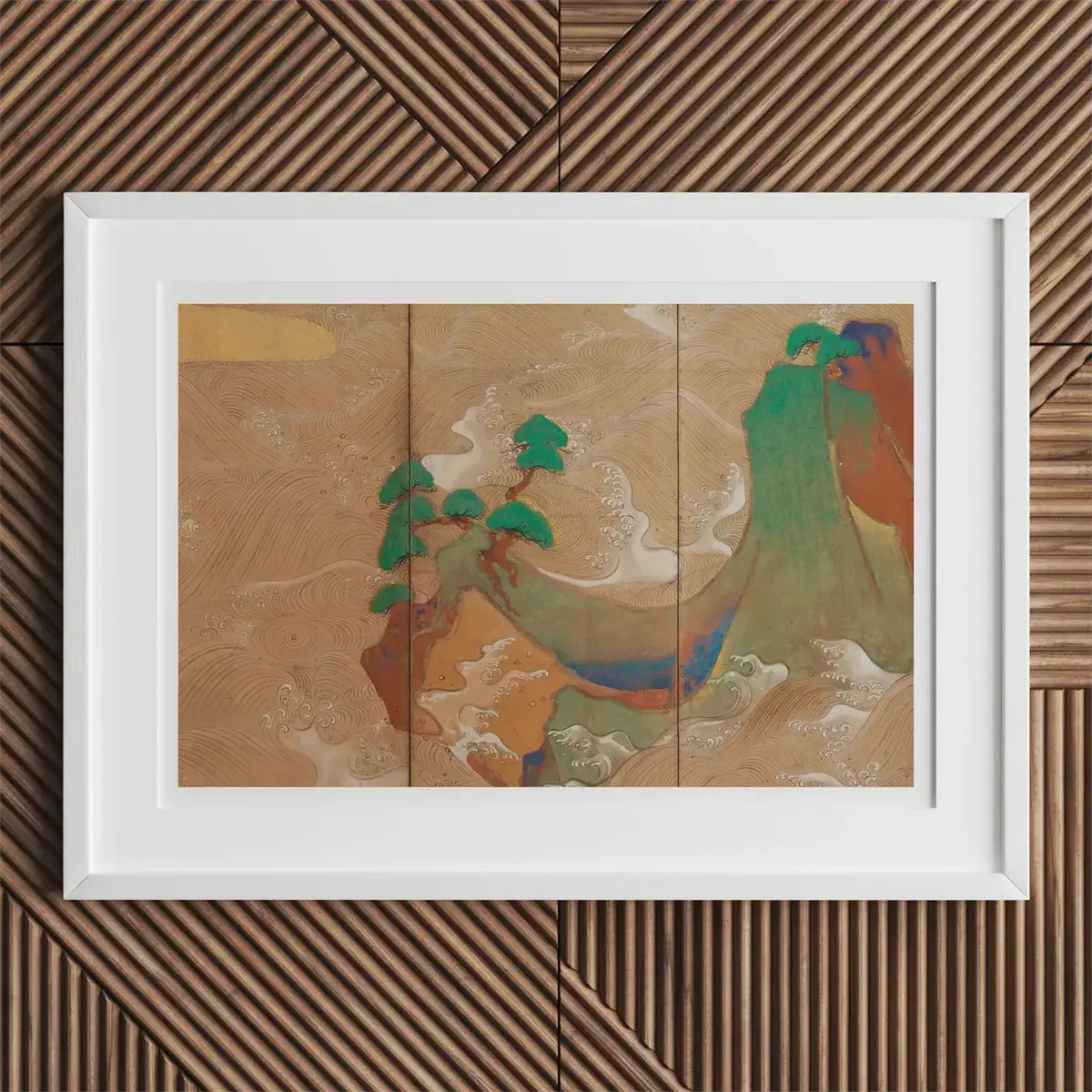
Perhaps the first thing that greets the eye when beholding a Rinpa creation is its thunderous use of color-rich, saturated, and joyous, with a flair for dramatic contrasts.
Rinpa works are instantly distinguishable by such vibrant hues, an inheritance from the classical yamato-e tradition that the earliest Rinpa artists revived and rewove to suit their own era. Expensive mineral pigments were ground and handled with a jeweler’s care, yielding blazing reds, delicate greens, and shimmering blues that glowed against backdrops of gold or washi paper.
Color was never superficial in Rinpa: it was a deliberate conversation about energy and mood. These majestic hues might evoke the evanescence of cherry blossoms in spring or the fiery collage of maple leaves in autumn. They could heighten the spiritual mood in a Buddhist theme or lend an ethereal hush to a depiction of moonlit water.
By engaging bold color, the Rinpa School cemented its reputation for bridging aesthetic pleasure with symbolic undertones, capturing drama, ecstasy, or quietude in equal measure.
The Art of Chance: Unraveling the Mysteries of Tarashikomi
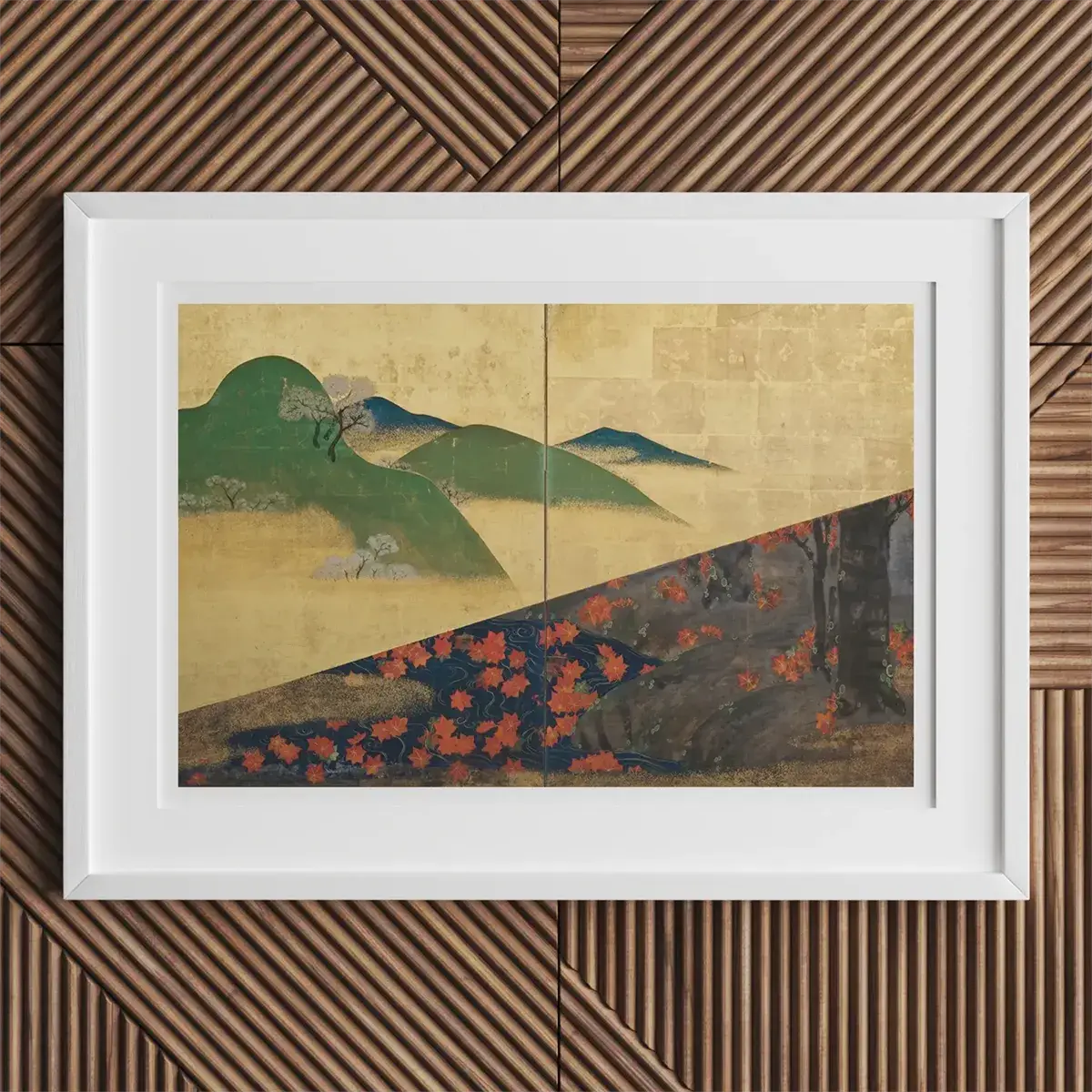
If color is the beating heart of Rinpa, then tarashikomi is its breath-a signature painting technique that channels chance into a mesmerizing play of bleeds and blooms.
Translating to “dripping in,” tarashikomi involves layering paint or ink onto a surface before the previous layer has dried. The results defy predictable outlines: pigments flow into each other, forming blurred edges, pooled colors, and evocative textures that might recall swirling clouds or the shimmering surface of a pond in moonlight.
Artists often used tarashikomi as a counterpoint to the more stylized or patterned elements on a screen, wedding the crisp clarity of a motif with an area that seemed to breathe of its own accord. The natural bleed of contrasting color introduced a dreamlike softness, a phenomenon of accidental blurring that demanded both bravery and mastery.
Painted on an absorbent surface, particularly if gold leaf was involved, tarashikomi could be merciless; yet in the hands of a gifted Rinpa artist, it revealed an almost cosmic, watery depth.
To compound this effect, some compositions featured mokkotsu, the so-called “boneless” technique where forms are suggested rather than strictly outlined. In a sense, mokkotsu echoed Buddhist musings on the transient and illusory nature of the world; a stroke of paint, unbound by lines, becomes a metaphor for existence itself.
Nature’s Poetry: Language of Elegant Patterns and Motifs in Rinpa Art
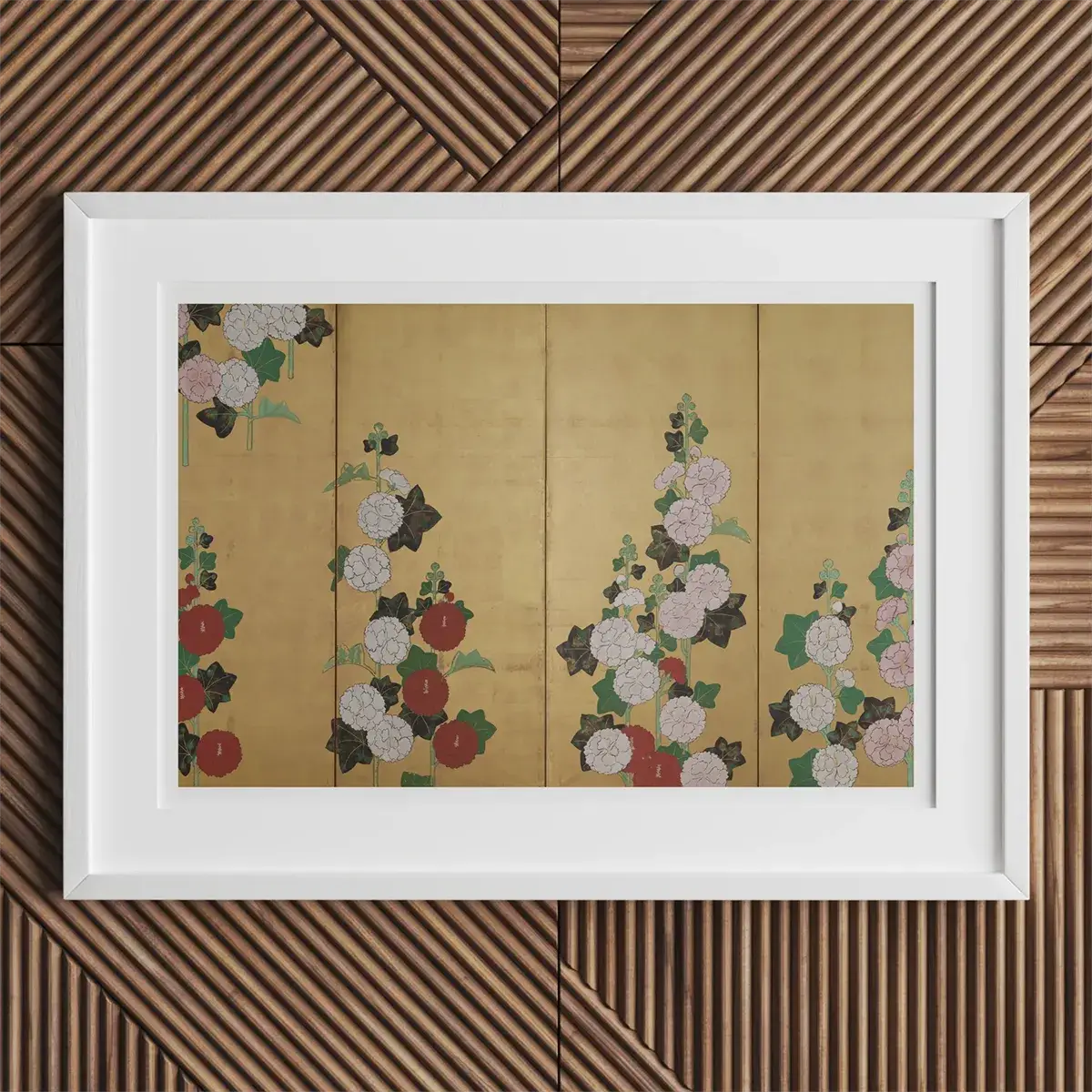
Few can resist the swirling magnetism of Rinpa’s patterned motifs—flowing water, fanning leaves, stylized feathers, and bold florals arranged in an orchestrated dance on screens, kimonos, and lacquerware. There is a comforting repetition, thanks in part to stencils and repeated shapes, but also a sense of spontaneity that breathes life into the compositions.
Rinpa’s reverence for the natural world manifested in motifs like grasses bending in the wind, clouds floating overhead, and splashes of water rendered with mesmerizing curves and delicate droplet-like circles.
The technique was as varied as the subjects: sometimes bold outlines flattened vegetation into silhouetted shapes; other times, layered color gradations hinted at the crispness of freshly fallen leaves. Metallic backgrounds, particularly in gold or silver leaf, heightened the impression that one was witnessing nature rendered in a dream-scape.
You might see frolicking tigers, or poetic cranes, or fish glimpsed through luminous waves. Each creature was stylized enough to be decorative yet animated enough to evoke real wonder. That blend—somewhere between design and living presence—remains one of Rinpa’s greatest triumphs.
Whispers of the Classics: Enduring Influence of Literature on Rinpa Themes
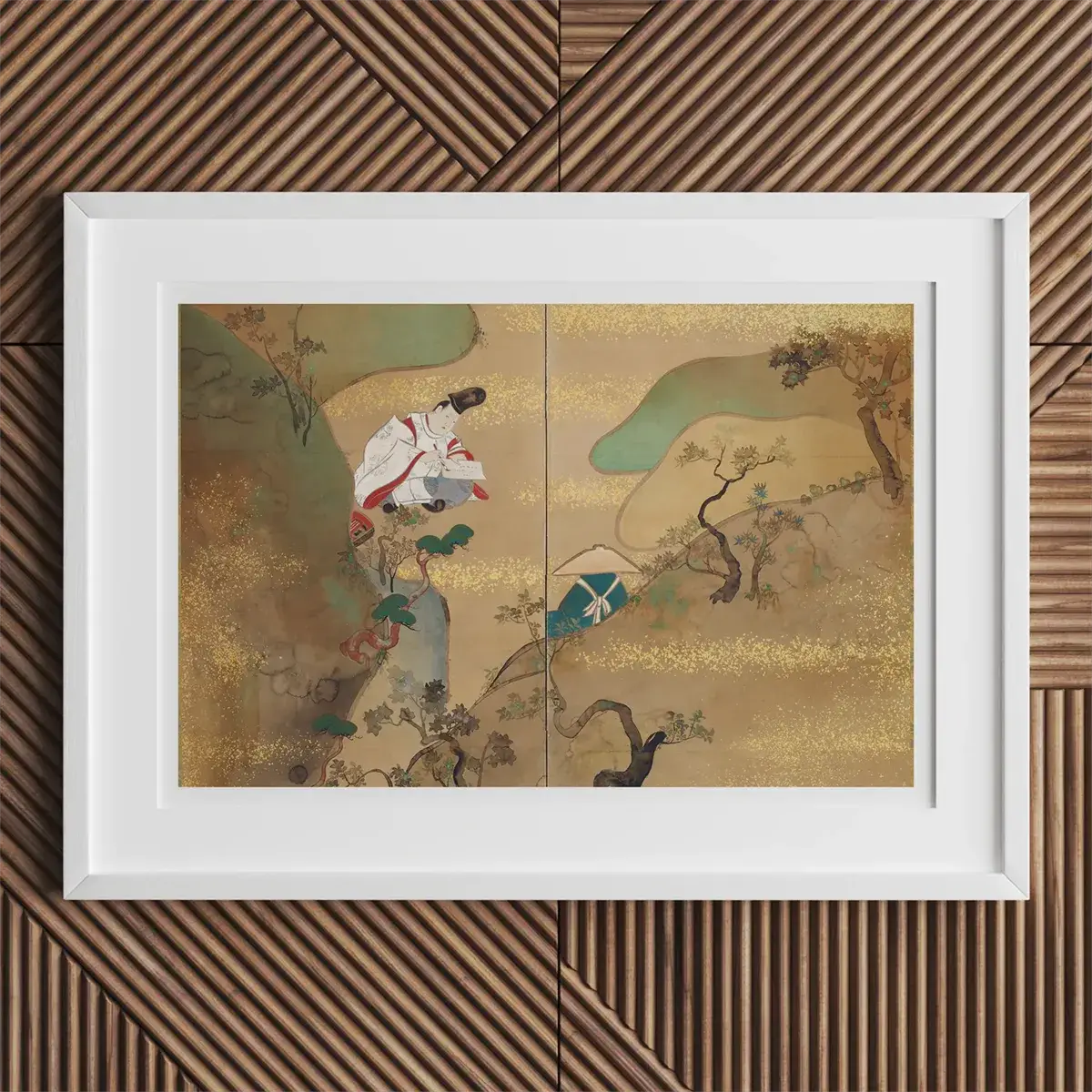
Long before electronic media, the Japanese literate class treasured hand-copied tales and poems as a fundamental measure of sophistication. Little wonder, then, that Rinpa art so frequently references classical Japanese literature, chief among them The Tale of Genji. To a Japanese audience, these references read like graceful winks, calling to mind longing glances on a veranda, lovers meeting in secret, or morning dew on a garden path.
Rinpa’s synergy with literary tradition was not simply homage; it was also a statement of cultural pedigree. By visually alluding to revered texts, Rinpa artists aligned themselves with the refined aura of the Heian court, while also bridging the centuries.
Whether capturing the cyclical progression of the four seasons or weaving in the ephemeral drift of cherry blossoms, a single panel could evoke entire chapters of Japanese history and emotion. Patrons who could parse these subtexts—who recognized poetic lines, symbolic birds, or references to a specific Genji chapter—took special delight in this layered sophistication.
A Touch of Opulence: Symbolism and Application of Gold and Silver Foil
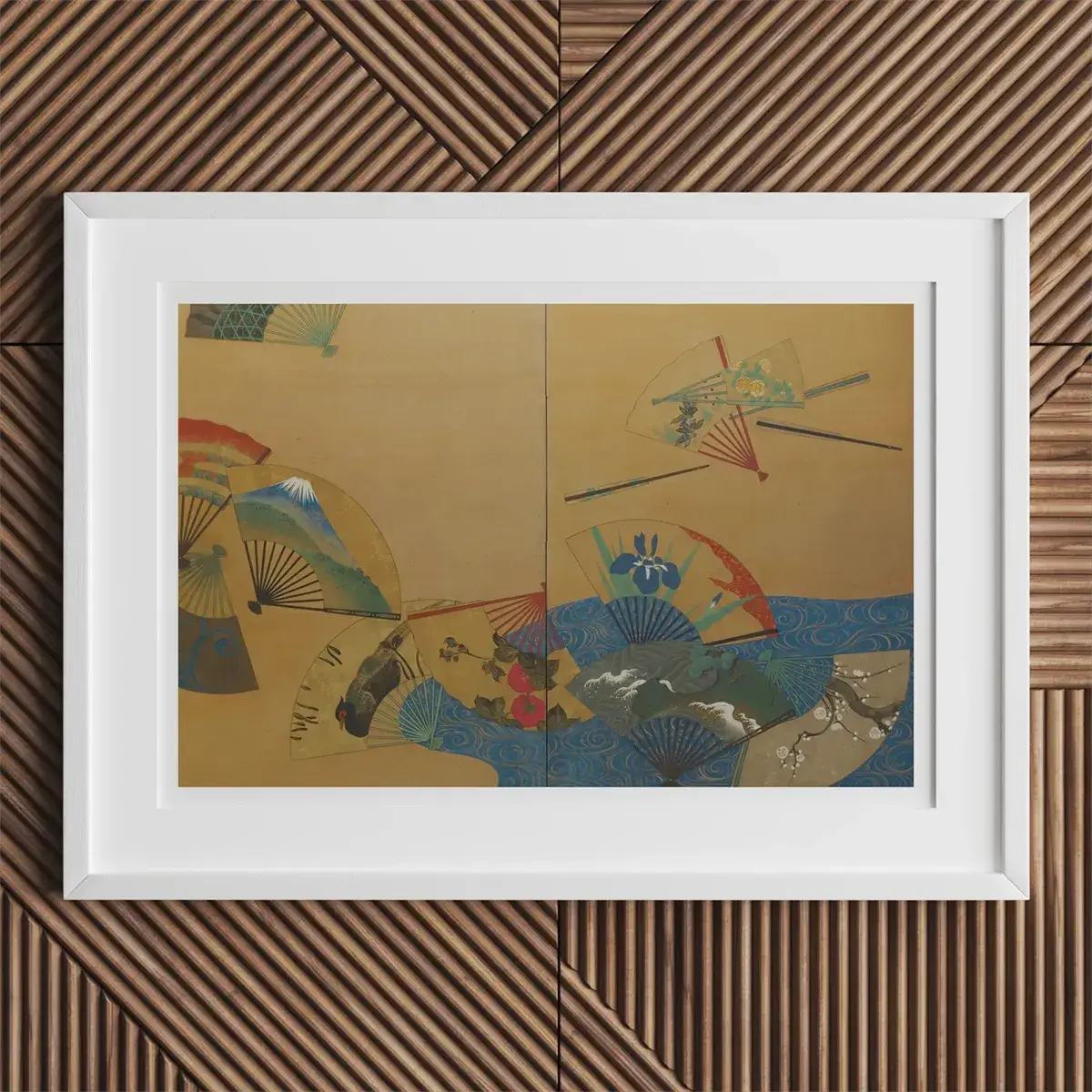
Set foot in a dimly lit hall where a gilded Rinpa screen stands, and you might sense that the room itself has grown brighter. That is the power of gold and silver foil: to transform any surface into a reflection of light. For centuries, Japanese culture has associated gold with wealth, elegance, and even immortality, while silver speaks to purity and moonlit refinement.
Rinpa artists often employed these precious metals to dramatically offset vivid mineral pigments, turning the background into a luminous field that could cradle or highlight the subject. A flock of bright-red maple leaves might stand out against the gentle shimmer of silver foil, while a blossoming branch, rendered in cobalt or vermilion, glows against a golden expanse as though touched by the sun.
This was never excess for the sake of it. Rather, it stood in a long lineage of Japanese artistic practice—yamato-e and Muromachi ink painting also dabbled with gold surfaces. In Rinpa’s hands, though, the effect was heightened: the metals served both decorative and narrative purposes, hinting at intangible realms of spirit and imagination.
Rinpa Beyond Painting: Extending Techniques Across Diverse Media
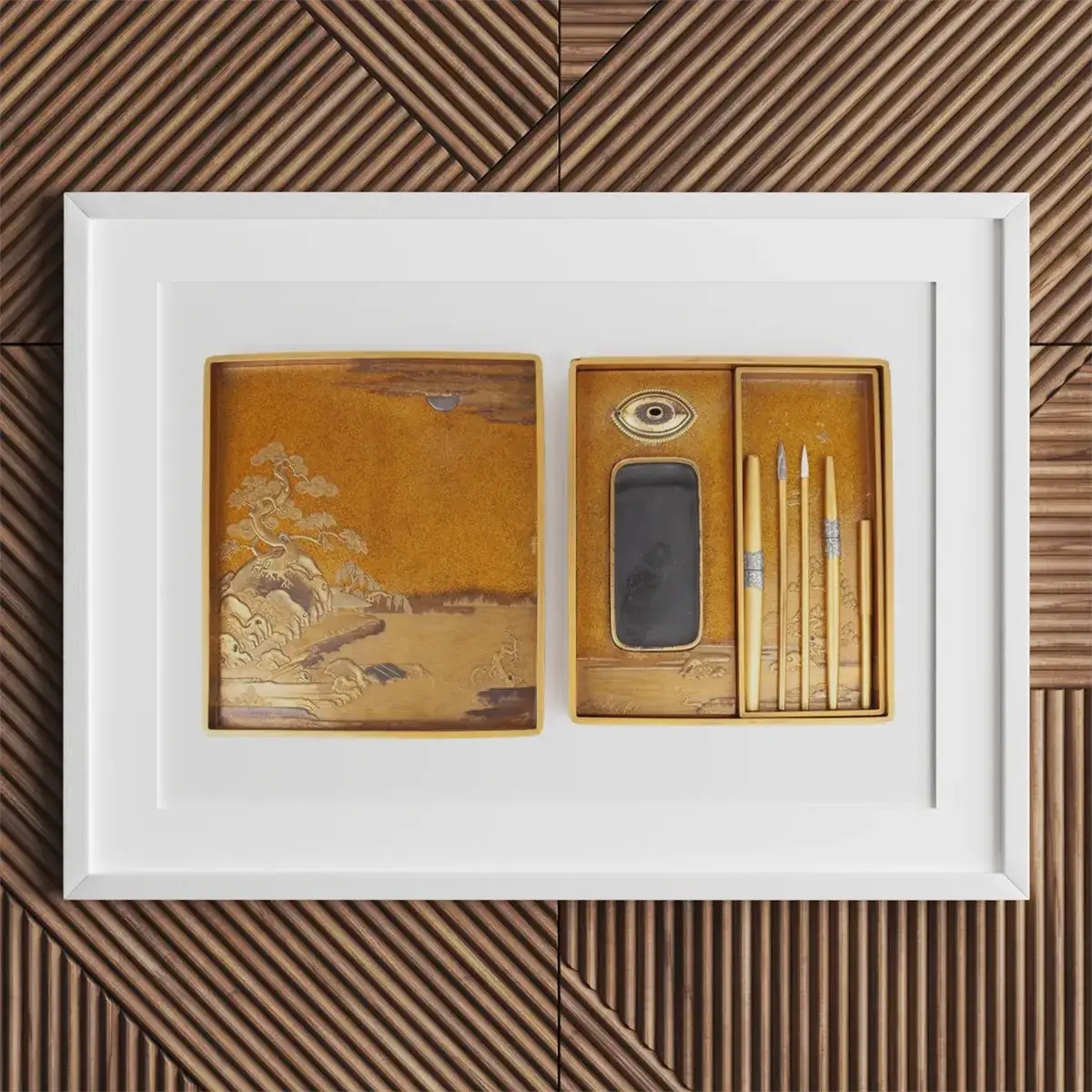
An enthralling hallmark of Rinpa is how it transcended the boundaries of a single medium. Quite unlike some Western schools that remain entrenched in painting, Rinpa soared across textiles, ceramics, lacquerware, and even woodblock prints. This was partly driven by the collaborative workshop atmosphere that characterized Japanese artistic circles in the Edo period; a single theme, motif, or composition could be remixed in clay, ink, or gold leaf.
In kimono fabrics, bold stylized florals sprang to life under the shimmering presence of metallic leaf and organic dyes. On ceramics, swirling glazes mimicked the watery effects of tarashikomi, while stylized fish or foliage repeated across a plate’s curvature. Lacquerware-especially prized by the merchant class-adorned trays, boxes, and tea ceremony implements with maki-e (powdered gold or silver) or raden (mother-of-pearl inlay) shaped into cranes or swirling waves reminiscent of Sōtatsu’s designs. Even in woodblock prints, beloved by the public and aristocrats alike, the Rinpa flair for color and refined composition found eager acceptance.
Such cross-pollination was not a coincidence; it was an intrinsic principle of Rinpa. The school’s relative lack of hierarchical constraints meant artists felt free to unite different disciplines. The result was a glorious tapestry of mediums speaking one aesthetic language.
Pantheon of Masters: Contributions of Key Rinpa Artists
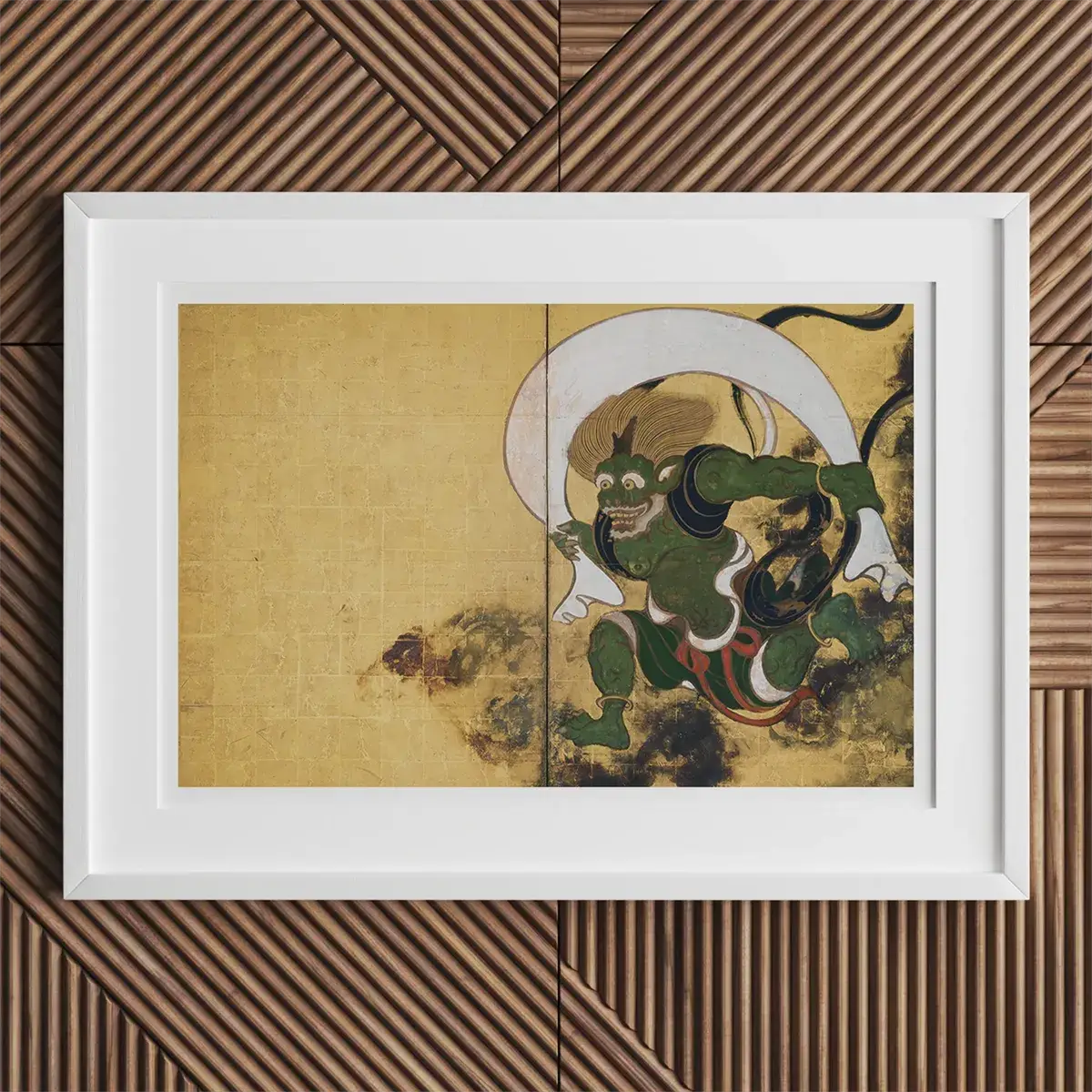
Each historical epoch gave rise to bright luminaries who carried the torch of Rinpa across centuries and mediums alike.
Tawaraya Sōtatsu stands among its founding giants, revered for his innovative painting techniques, bold colors, and the invention of tarashikomi that enriched so many compositions. One can still marvel at his “Wind and Thunder Gods” screens or the dynamic swirls in “Waves at Matsushima,” where gold leaf and fluid brushstrokes fuse into a vibrant visual feast. His partnership with Hon'ami Kōetsu left us luminous calligraphic works that balanced text and image with near-symphonic grace.
Ogata Kōrin, the figure whose very name now defines Rinpa, orchestrated a grand revival in the late seventeenth and early eighteenth centuries. His push toward abstraction, color gradations, and lavish materials like gold and pearl influenced countless artists in decorative arts. The screens “Irises at Yatsuhashi” and “Red and White Plum Blossoms” remain iconic, bridging the real and the dreamlike in a single sweep of color.
Ogata Kenzan, Kōrin’s gifted younger brother, specialized in pottery. In his Kenzan ware, swirling glazes and streamlined motifs echo the same orchestrations found on Kōrin’s painted screens. It was a fraternal collaboration that embodied the interdisciplinary nature of Rinpa: a single design might migrate from textile to ceramic to painting.
Sakai Hōitsu, overshadowed by the brilliance of Kōrin, nonetheless performed a crucial guardianship of Rinpa in nineteenth-century Edo. Through diligent study and re-creations of Kōrin’s works, he both honored and codified the style.
By introducing greater focus on seasonal imagery, Hōitsu expanded the thematic repertoire. His “Flowering Plants of Summer and Autumn” even shares physical space with Kōrin’s “Wind God and Thunder God,” an intergenerational dialogue across the same surface.
Suzuki Kiitsu, Hōitsu’s favored pupil, gently steered Rinpa toward refined naturalism, capturing the delicate essence of flowers and plants. Under Kiitsu, Edo audiences glimpsed a subtler, maybe more introspective version of Rinpa, a testament to the movement’s capacity to evolve.
Finally, in the early twentieth century, Kamisaka Sekka inherited this grand tradition and boldly wove in Art Nouveau influences. His cross-medium approach, spanning painting, printmaking, ceramics, and lacquerware, breathed new life into Rinpa’s signature patterns.
“Rinpa” was no relic; it was an ethos that could roll smoothly into the modern age, glimmering with the same unbounded creative spark that first illuminated a lacquer box in 17th-century Kyoto.
East Meets West: The Influence of Rinpa on Global Art Movements
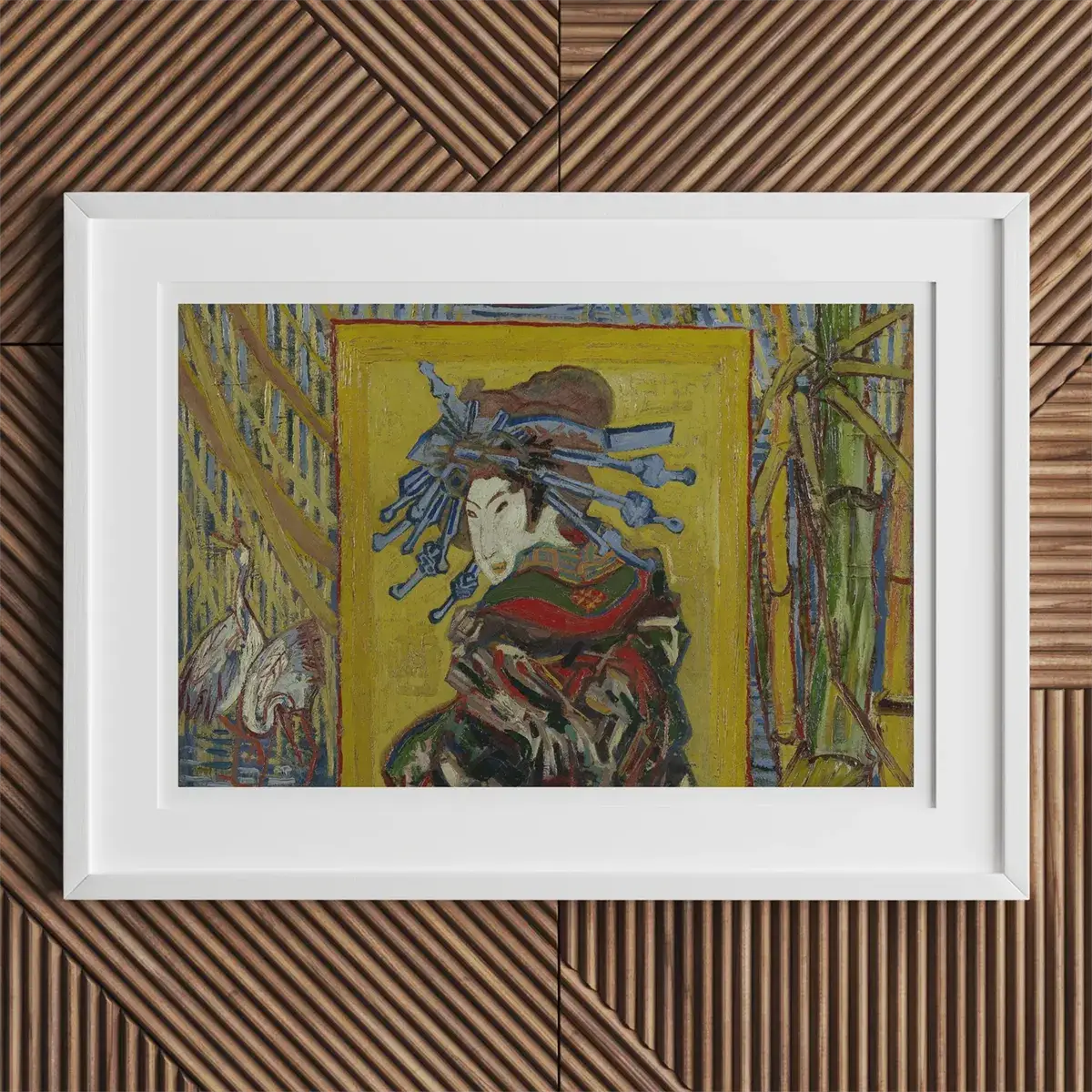
In the late nineteenth century, the closed doors of Japan swung open to foreign curiosity. Western travelers, scholars, and collectors streamed into the country, eager to unearth what had previously been a near-mythic culture. This dramatic shift helped propel Rinpa onto the global stage, intersecting with the feverish Japonisme trend in Europe.
Prized lacquerware, textiles, and ceramics bearing Rinpa-inspired motifs found their way into Parisian drawing rooms and London auction houses. Indeed, by the dawn of the 20th century, Western eyes had grown enamored with everything from Hiroshige’s woodblock prints to the ornamental swirl of Rinpa flowers.
The movement’s emphasis on clean lines, organic shapes, and color blocking captivated the European avant-garde, especially the French Impressionists and Post-Impressionists. Stories abound of Paul Gauguin and Vincent van Gogh swooning over Japanese aesthetics: van Gogh famously referred to the sun-baked fields of southern France as “his Japan.”
Around the same time, Art Nouveau blossomed in Europe’s great cities, spinning stylized vines and floral tendrils across furniture, glassware, and architecture. Its sinuous forms, reverence for nature, and bold ornamental approach reveal an unmistakable debt to Rinpa’s swirling lines and pattern repetition. Indeed, one can trace a direct line from a Rinpa screen’s stylized iris to the arabesques on an Art Nouveau poster in 1890s Paris.
Today, the Rinpa current still ripples through the worlds of painting, couture fashion, graphic design, and architecture. Contemporary artists incorporate its synergy of color, line, and nature in unexpected ways, bridging the centuries in an ongoing conversation about how tradition can inform modernity.
The Timeless Resonance of Rinpa
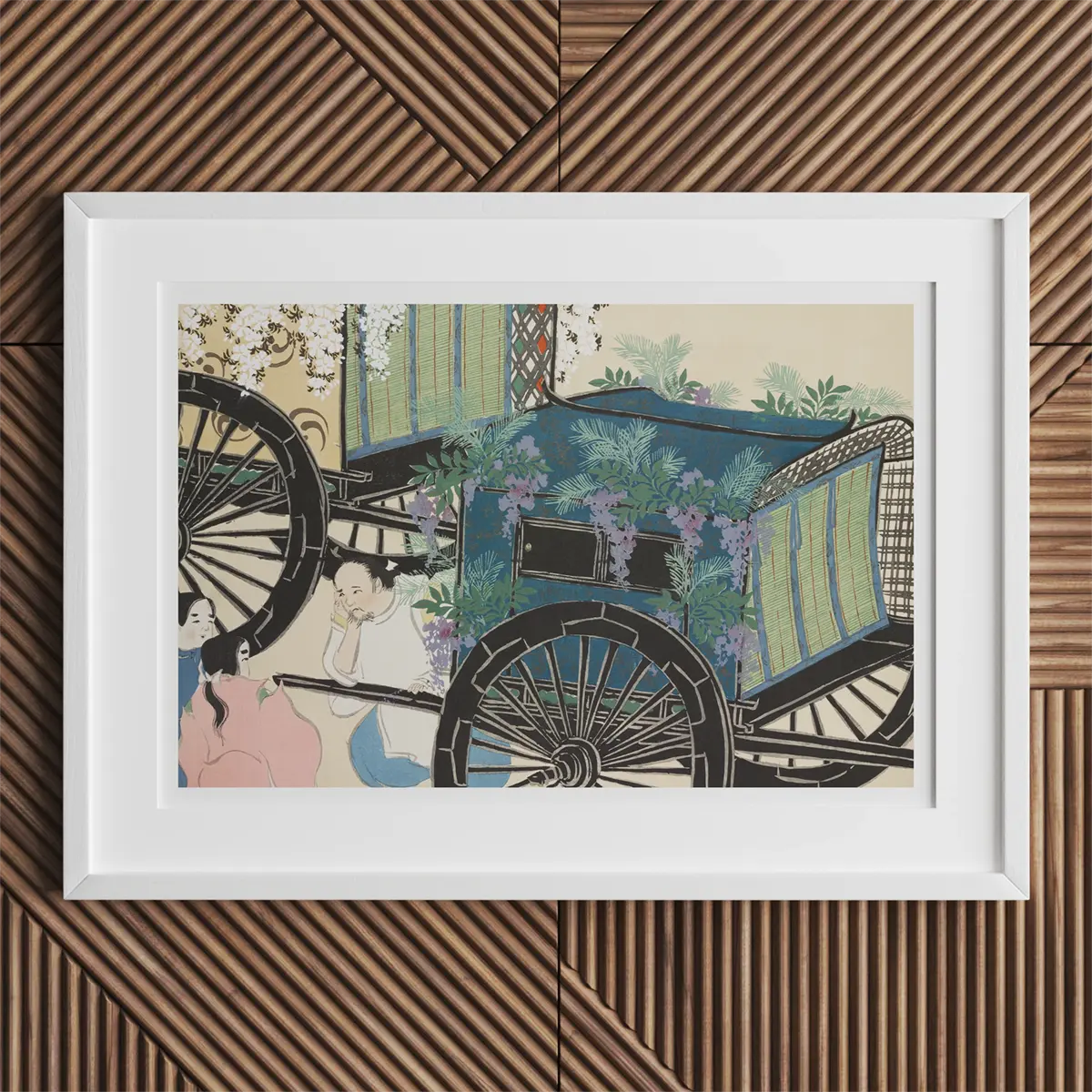
Rinpa’s endurance lies not in its adherence to one strict set of rules, but in its profound willingness to adapt and absorb. It fused the dignity of Heian-court aesthetics with Edo’s mercantile energy, then found fresh relevance in Tokyo’s nineteenth-century swirl. Crossing oceans, it even fed into Western modernist vocabularies. At each juncture, Rinpa’s essential core—bold, luminous color, lyric patterns, and innovative techniques—remained intact, a signpost for artistic freedom and collaboration.
As we look upon a Rinpa screen today, the drama of swirling water or a single, flamboyant plum blossom can feel startlingly modern. One might sense centuries collapsing: from the hush of a Kyoto temple to a Parisian atelier in 1900, from a tatami-floored workshop in Edo to a New York gallery.
Simultaneity is Rinpa’s true genius. It is at once an ode to classical literature and a celebration of nature’s riotous color; a place where calligraphy, painting, ceramics, and spiritual devotion intersect in perpetually fresh constellations.
When the gold foil catches the light, dancing across a painted wave, you see the centuries-old brushwork glimmer as if newly laid. There, in the hush and the glow, the Rinpa School still whispers: art lives, transforms, endures.
Through vivid hues and evocative patterns, Rinpa invites us into a realm where technique meets chance, tradition meets daring, and the ephemeral meets the eternal. That, ultimately, is Rinpa’s timeless promise—a testament to the unbreakable power of vision, invention, and collaboration.


